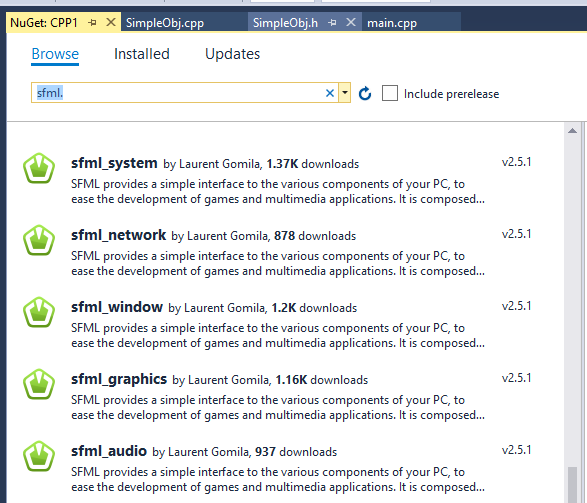Difference between revisions of "C++ Drawing to the screen"
(Created page with "=Using Graphics.h= There are many libraries for drawing graphics to the screen, these examples will show the standard 'Graphics.h' approach. You can the required files from: [...") |
(→Drawing a Rectangle) |
||
| (5 intermediate revisions by the same user not shown) | |||
| Line 1: | Line 1: | ||
| − | = | + | =SFML= |
| − | + | This method will require you to install some packages. In Visual Studio, and Project, select 'Manage Nuget Packages'. | |
| − | + | Click the browse tab and type: | |
| − | + | 'sfml' | |
| − | + | ||
| − | #include < | + | Now look for the version numbers, each version has a slightly different name. I have found: |
| − | + | ||
| − | + | [[File:Sfml.png]] | |
| − | int main() | + | |
| − | { | + | SFML has 5 different components, so click each one and click install. |
| − | + | ||
| − | + | ==Creating A Window== | |
| − | + | The code below will create a window, and also provides a loop to keep the window open and to check for window events: | |
| − | + | ||
| − | + | <syntaxhighlight lang=c++> | |
| − | + | #include <SFML/Graphics.hpp> | |
| − | + | ||
| − | + | int main() | |
| − | + | { | |
| − | + | sf::RenderWindow window{{ 800, 800 }, "Window Title"}; | |
| − | + | window.setFramerateLimit(60); | |
| − | + | ||
| − | + | while (window.isOpen()) | |
| − | + | { | |
| − | + | sf::Event event; | |
| − | + | while (window.pollEvent(event)) | |
| − | + | { | |
| − | + | if (event.type == sf:: Event::Closed) | |
| + | { | ||
| + | window.close(); | ||
| + | } | ||
| + | } | ||
| + | window.clear(); | ||
| + | window.display(); | ||
| + | } | ||
} | } | ||
| + | </syntaxhighlight> | ||
| + | |||
| + | ==Drawing a Rectangle== | ||
| + | We can declare a rectangle, so after the 'window.setFramerateLimit(60)' line add: | ||
| + | |||
| + | <syntaxhighlight lang=c++> | ||
| + | sf::RectangleShape rectangle{ { 220.f, 160.f } }; | ||
| + | rectangle.setFillColor(sf::Color::White); | ||
| + | rectangle.setPosition({ 150.f, 20.f }); | ||
| + | rectangle.rotate(20.f); | ||
| + | </syntaxhighlight> | ||
| + | |||
| + | Now in between the 'window.clear()' and the 'window.display()' enter the following line to draw the rectangle: | ||
| + | |||
| + | <syntaxhighlight lang=c++> | ||
| + | window.draw(rectangle); | ||
| + | </syntaxhighlight> | ||
Revision as of 14:50, 13 June 2019
SFML
This method will require you to install some packages. In Visual Studio, and Project, select 'Manage Nuget Packages'.
Click the browse tab and type:
'sfml'
Now look for the version numbers, each version has a slightly different name. I have found:
SFML has 5 different components, so click each one and click install.
Creating A Window
The code below will create a window, and also provides a loop to keep the window open and to check for window events:
#include <SFML/Graphics.hpp>
int main()
{
sf::RenderWindow window{{ 800, 800 }, "Window Title"};
window.setFramerateLimit(60);
while (window.isOpen())
{
sf::Event event;
while (window.pollEvent(event))
{
if (event.type == sf:: Event::Closed)
{
window.close();
}
}
window.clear();
window.display();
}
}
Drawing a Rectangle
We can declare a rectangle, so after the 'window.setFramerateLimit(60)' line add:
sf::RectangleShape rectangle{ { 220.f, 160.f } };
rectangle.setFillColor(sf::Color::White);
rectangle.setPosition({ 150.f, 20.f });
rectangle.rotate(20.f);
Now in between the 'window.clear()' and the 'window.display()' enter the following line to draw the rectangle:
window.draw(rectangle);
